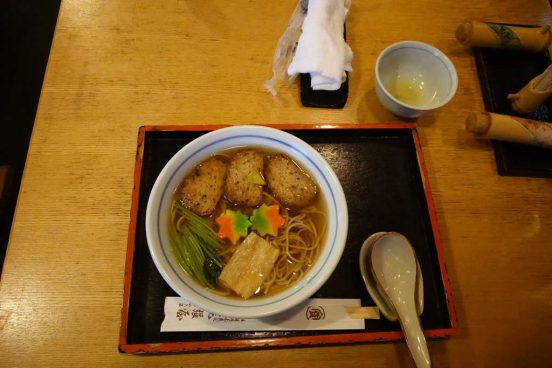Most places where it is grown, buckwheat is considered a coarse and inferior grain, only good for its hardiness. But then, trends give new status, a place like Honke Owariya shows the power of tradition – and nicely illustrates the connection to spice.
Cheap Buckwheat, Soba, Superfood
With the rise of “superfoods” and special grains like quinoa and amaranth, its outsider status has also given buckwheat a new standing, though.
Russians and neighbors may use it quite a bit; Bhutan has quite the tradition with it – but it is in Japan and Japanese cooking where it rises to peculiar heights. Particularly so because buckwheat is the major ingredient of soba.
Traditional, Not Just the Building
Honke Owariya as a building is a similarly old-style structure as that of Kanda Matsuya in Tokyo: low, two-story, mainly wood.
There is a small entrance area inside with a shop selling their confectionery and housing the cashier’s; dining rooms go off from there, including up to the second floor.
In Kyoto and its environs, such old(-fashioned) buildings are hardly unusual; they are interesting, anyways. With a shop like Honke Owariya that has been in operation for more than 500 years, particularly so.
Honke Owariya actually started out as a confectionery shop, using at least some buckwheat flour in their sweets. They have become better known for their soba, however.
The Thing with Buckwheat – and Spices
As a rather peculiar ingredient, a crop of higher altitudes and colder regions, I find myself quite interested in buckwheat, hence also in soba.
All the more so as, contrary to much popular belief (and even research), the chile peppers find a particular popularity not just in the tropics. They are there, certainly, but chile peppers (and some other hot flavors) are also aromas of the cold mountains – and to be found in combination with buckwheat, including on soba in Japan.
At Kanda Matsuya in Tokyo, the usual spices were just simply on the table. Honke Owariya took it on themselves to explicitly point them – sansho and shichimi – out in the English version of their menu.
Recommended use: “Sprinkle sparingly over your hot noodle dishes.” Ex-actly.
The Food
Honke Owariya as a restaurant has quite an extensive menu, at least if one counts everything they have to offer. There are quite a few appetizers (hors d’oeuvres), many cold and even more hot noodle dishes, various rice bowls (donburi), and finally, four house specialities.
Not easy to decide.
What I went for was the (speciality, to make things a bit easier) Rikyu Soba, which is a “kake-soba with rikyu-fu, mitsuba, and yuba aromatized with yuzu peel.”
Translation: A simple hot soup of buckwheat soba noodles with sweet fried gluten pieces, Japanese parsley, and tofu skin, with the soup flavored with some Japanese citrus peel.
So, yes, another citrusy and slightly sour broth with soba. It was similarly light as the one at Kanda Matsuya, quite refreshing and aromatic. Sansho or (and) shichimi fit rather better in it than one might expect of something so light and ‘soft’ in flavor, but the aromas are not to be underestimated, either.
There is something to learn and think about. Not just regarding buckwheat and chilli and cold mountains, but also around citrus and chilli – which, actually, is something that we will encounter again; it is a combination that has its tradition and popularity in Japan, and a mix that is surprisingly uncommon elsewhere…
Basic Information
Honke Owariya
(In Japanese: 本家尾張屋)
Original store:
322, Niomontsukinukecho,
Nakagyo-ku Kyoto-shi,
Kyoto, 604-0841, Japan
(There are three other branch locales in the center of Kyoto)
Price range 800-2000 (3000) JPY
Open 11:00 to 19:00 ( last order 18:30 )
*sweets sale from 9:00
Closed January 1st, 2nd
Reservations possible online; not so few seats available (either on chairs or on tatami mats).
Cash only (?)
Website: https://honke-owariya.co.jp/en/



Leave a Reply
You must be logged in to post a comment.